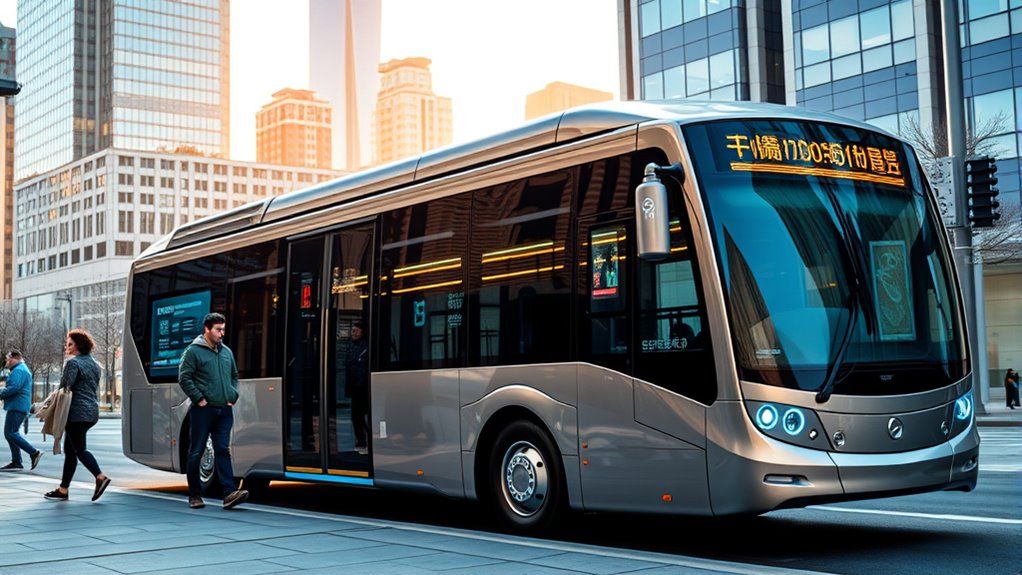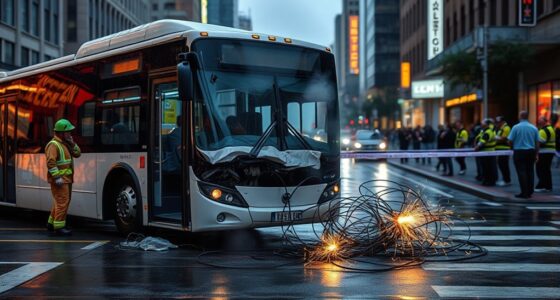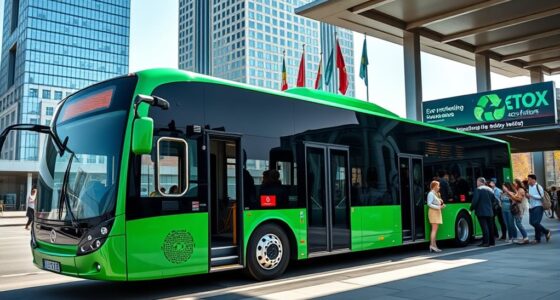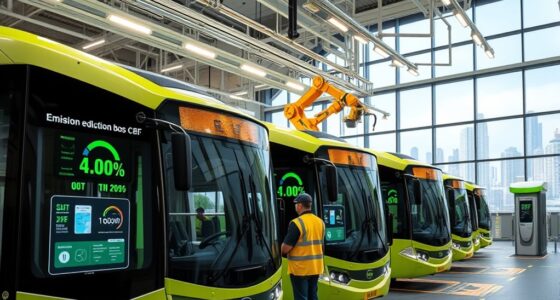As electric bus regulations become more stringent globally, expect stricter emission standards, expanded charging infrastructure, and increased government incentives to support adoption. Policies will push for modernization of electrical grids and faster charging technologies, making electric buses more practical and affordable. Innovations like autonomous buses and vehicle-to-grid systems will enhance efficiency. Staying ahead means understanding how these evolving regulations could shape sustainable urban transit—continue exploring to see what’s coming next.
Key Takeaways
- Expect stricter emission standards worldwide to accelerate electric bus adoption and phase out diesel-powered fleets.
- Governments will likely introduce more subsidies and incentives to lower upfront costs for electric bus operators.
- Infrastructure development, including rapid charging stations and grid upgrades, will become a regulatory priority.
- Future regulations may incorporate autonomous and V2G technologies to enhance efficiency and grid integration.
- Increased public and environmental pressure will drive policies promoting renewable energy integration with electric bus systems.

The future of electric bus regulation is shaping up to markedly accelerate the shift toward cleaner urban transportation worldwide. Governments are setting ambitious targets, like the European Union’s mandate for 100% zero-emission bus sales by 2025, which pushes manufacturers and transit agencies to prioritize electric options. These regulations not only promote adoption but also create a more predictable environment for investment and innovation.
Global regulations are accelerating the shift to cleaner urban transportation and fostering innovation in electric bus technology.
Stricter emission standards are being enforced globally, compelling traditional diesel bus operators to switch to cleaner alternatives. These standards aim to cut pollutants considerably, making cities healthier and reducing their carbon footprints. As these regulations become more stringent, the importance of compliance and innovative solutions grows among manufacturers and operators alike.
In the United States, tariffs on Chinese-made buses influence the market dynamics, encouraging local manufacturing and fostering domestic innovation. Meanwhile, individual states are implementing policies to modernize electrical grids and expand EV charging infrastructure. These initiatives make it easier for transit agencies to deploy electric buses without worrying about charging logistics, ensuring smoother integration into existing transportation networks. Additionally, the development of advanced charging stations is critical to supporting the rapid deployment of electric bus fleets. Investing in infrastructure upgrades is also essential to accommodate the growing demand for electric buses and facilitate seamless operation.
Furthermore, integrating renewable energy sources into the grid can maximize the environmental benefits of electric buses, making their operation even cleaner and more sustainable.
Governments worldwide are also offering subsidies and incentives to lower the financial barriers for transit authorities and private operators, accelerating the shift to electric fleets. These financial incentives are essential for overcoming initial costs and encouraging rapid adoption.
On the technological front, advances in battery technology are reshaping the industry. Semi-solid-state batteries, which are being tested, promise longer ranges and greater efficiency, making electric buses more practical for daily use. Vehicle-to-grid (V2G) systems, allowing buses to feed energy back into the grid during peak demand, are enhancing energy efficiency and offering cost savings. High-quality equipment for sound recording is essential for documenting these technological innovations and industry changes.
Autonomous electric buses are emerging as a future mobility solution, potentially reducing operating costs and improving safety and reliability. Faster charging technologies are also making electric buses more viable by minimizing downtime, enabling longer routes and higher utilization rates. These innovations are expected to revolutionize urban transit and reduce dependency on fossil fuels.
Market projections highlight the rapid growth of this sector. The electric bus market is expected to reach $187.8 billion by 2032, driven by increasing sales—almost 50,000 units sold globally in 2023—and a total stock of around 635,000 buses.
Regions across the globe are adopting electric buses at a growing pace, partly driven by environmental pressures and public demand for cleaner urban air. Domestic manufacturers in the U.S. are gaining a competitive advantage due to tariffs on imports, further shaping the market landscape.
Environmental benefits are at the core of these regulatory changes. Electric buses produce zero tailpipe emissions, helping cities reduce air pollution and meet climate goals. They also operate more quietly and can utilize renewable energy sources, amplifying their positive impact.
As public awareness of climate change increases, support for electric buses grows, driven by the promise of improved air quality and healthier communities. Together, these regulatory developments, technological innovations, and market trends are creating a robust framework for a cleaner, more sustainable future in urban transportation.
Frequently Asked Questions
How Will Regulations Impact Electric Bus Prices?
Regulations will likely push electric bus prices higher initially, as stricter emission standards and deadlines increase demand.
You might see incentives and subsidies help offset costs, making buses more affordable.
As manufacturers respond to these regulations, competition could grow, lowering prices over time.
Technological advances and economies of scale will further reduce costs, making electric buses more accessible and cost-effective for your fleet in the long run.
Will There Be Incentives for Electric Bus Manufacturers?
Oh, so you’re wondering if electric bus manufacturers will get more incentives? Ironically, yes, they already do, with federal funding, state programs, and proposed multibillion-dollar investments. These incentives aim to reduce costs, boost innovation, and grow the market.
Expect even more support soon, especially with stricter domestic content rules and technological advancements. So, instead of facing hurdles, you’ll find increased backing to drive electric bus growth.
How Will Existing Diesel Bus Fleets Transition?
You’ll see existing diesel bus fleets shifting mainly through retrofitting and new purchases. Retrofitting involves upgrading buses with modular batteries, taking 3–6 months, and extending their service life by 5–10 years.
Alternatively, you can replace older buses with new electric models, which offer longer range but take longer to deploy. Many districts use grants and partnerships to offset costs, making the switch more affordable and efficient.
What Safety Standards Will Be Mandated?
You’ll see safety standards that set clear expectations, from federal oversight to industry best practices, state and local codes, and continuous updates. These standards will mandate rigorous hazard identification, risk management, and battery safety protocols.
You’ll also need to follow specific training requirements for drivers, technicians, and first responders, ensuring everyone understands safety mechanisms, emergency procedures, and proper maintenance—creating an all-encompassing safety network that keeps everyone safe on the road.
How Will Regulations Address Charging Infrastructure?
You’ll see regulations requiring high-power fast chargers, like 165-600 kW, to minimize downtime, and standards aligned with SAE J2910 and J2344 for safety and compatibility. You’ll need to plan for infrastructure that scales non-linearly with fleet size, coordinate with utilities, and include safety features like high-voltage labeling and fire suppression. Regulations will also specify placement, blocking requirements, and maintenance protocols to guarantee operational efficiency and safety.
Conclusion
As the road ahead brightens with new regulations, think of these rules as the compass guiding electric buses toward a cleaner, greener horizon. You’ll find that clear standards and supportive policies act like a sturdy engine, powering innovation and sustainability. Embrace this evolving landscape, where regulations serve as the wind in your sails, steering you toward a future where every ride contributes to a healthier planet. The journey’s just beginning, and the road is yours to shape.









